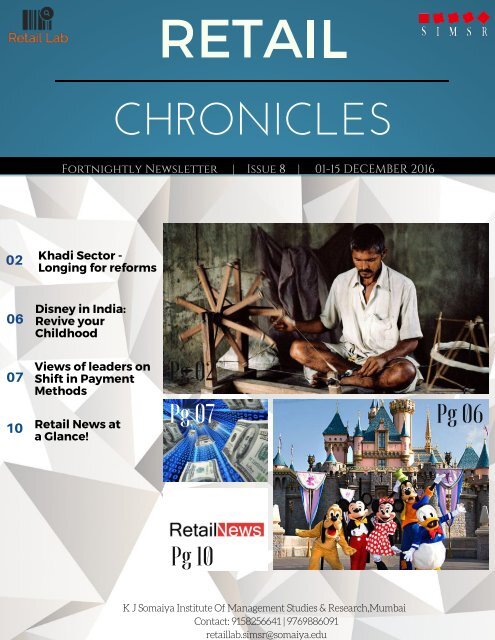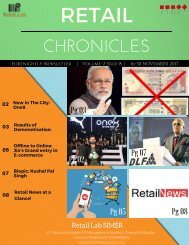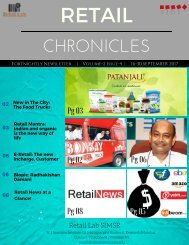Retail Chronicles Issue8 (01-15 December 2016)
You also want an ePaper? Increase the reach of your titles
YUMPU automatically turns print PDFs into web optimized ePapers that Google loves.
J Somaiya Institute Of Management Studies & Research,Mumbai<br />
K<br />
9<strong>15</strong>8256641 | 9769886091<br />
Contact:<br />
RETAIL<br />
CHRONICLES<br />
Fortnightly Newsletter | Issue 8 | <strong>01</strong>-<strong>15</strong> DECEMBER 2<strong>01</strong>6<br />
Sector -<br />
Khadi<br />
for reforms<br />
Longing<br />
02<br />
in India:<br />
Disney<br />
your Revive<br />
06<br />
Childhood<br />
of leaders on<br />
Views<br />
in Payment<br />
Shift<br />
07<br />
Pg 02<br />
Methods<br />
Pg 07 Pg 06<br />
News at<br />
<strong>Retail</strong><br />
Glance! a<br />
10<br />
Pg 10<br />
<strong>Retail</strong> Lab SIMSR<br />
retaillab.simsr@somaiya.edu
A S A T I S F I E D<br />
C U S T O M E R I S T H E<br />
B E S T B U S I N E S S<br />
S T R A T E G Y O F A L L .<br />
- MICHAEL LeBoeuf
Khadi Sector – Longing for Reforms!<br />
A recent report in the Times of India<br />
shows that the Khadi fabric and<br />
garments sales witnessed a 29%<br />
growth and crossed ₹1,500 crore mark<br />
for the first time. This announcement<br />
is very exciting in its nominal terms.<br />
However, a recent study conducted<br />
by CPPR in 2<strong>01</strong>5-16 on the Khadi<br />
sector provides quite contrasting<br />
insights on the sector. The study<br />
shows that the Government of India<br />
has spent large sums on Khadi sector.<br />
However, this sector has experienced<br />
a decline in production, sales and<br />
employment. Moreover, the huge<br />
amount spent for the economic<br />
empowerment of the poor artisans is<br />
not reaching their hands.<br />
All Is Not Well<br />
The annual reports of Ministry of<br />
Small and Medium Enterprises<br />
(MSME) show a rise in the plan and the<br />
non-plan amount spent on Khadi<br />
sector.<br />
By Vipul Varkar<br />
The plan amount shows a rise from<br />
₹194.27 crore to ₹ 1,454 crore and nonplan<br />
amounts from ₹43.7 crore to<br />
₹229.1 crore respectively in the period<br />
1994-95 to 2<strong>01</strong>4-2<strong>01</strong>5. The interest<br />
subsidies to Khadi institutions<br />
increased from ₹ 9.63 crore to ₹ 31.45<br />
crore in this period.<br />
At the same time, production and<br />
sales of Khadi . fabrics, adjusted for<br />
inflation, declined from ₹9.19 crore<br />
and ₹ 11.58 crore to ₹5.19 crore and<br />
₹6.09 crore respectively in the same<br />
period. The Comptroller and Auditor<br />
General (CAG) of India Audit report<br />
(Report Number 25 of 2<strong>01</strong>4) on Khadi<br />
and Village Industries Commission<br />
(KVIC) also reveals that KVIC is<br />
ineffective in utilizing the plan and<br />
non-plan funds for the Khadi sector<br />
promotion, clearly indicating the<br />
wastage of public money.<br />
02
The Inconvenient Truth<br />
According to MSME, only KVIC and<br />
KVIC certified institutions namely<br />
some NGOs are allowed to produce<br />
Khadi. This creates significant entry<br />
barriers. The Government imposed<br />
the certification process to protect<br />
the industry. However, it is not<br />
market-friendly and does not cater to<br />
the interests and tastes of the<br />
customers. Many weaving units have<br />
not produced any Khadi products.<br />
They emerge with the sole intent of<br />
getting KVIC rebates and other<br />
benefits. At the same time, this has<br />
also resulted in many piracy<br />
problems associated with Khadi<br />
industry. These include producing<br />
spurious products in the name of<br />
Khadi through unofficial channels.<br />
Moreover, the study proves that<br />
individual certification marks are<br />
becoming less important to the<br />
consumers in choosing products. This<br />
is because consumers select<br />
products largely based on the brand<br />
image rather than the certification<br />
marks<br />
Khadi fabrics are 02available<br />
mostly in<br />
KVIC certified stores only, restricting the<br />
availability of Khadi products to the<br />
consumers. In the Khadi retail outlets,<br />
the working times are the government<br />
office timings – from 10 am to 5 pm.<br />
When the whole marketing is adopting<br />
e-commerce, the stereotypes in Khadi<br />
sector are not doing anything good for<br />
the marketing.<br />
Only Khadi institutions undertake its<br />
marketing.<br />
Repercussions of Regulation<br />
Over-protection of the sector has<br />
resulted in poor branding and marketing<br />
plans. Furthermore, not many big<br />
players are in the field.<br />
The traditionalists still resort to the<br />
conventional print advertisements or<br />
banners and rebate schemes for<br />
marketing. The above-mentioned<br />
restricted practices have resulted in the<br />
decline of the production and sales of<br />
Khadi fabrics. It is mainly due to over<br />
bearance of KVIC in the sector.<br />
03
The primary objective of KVIC is<br />
employment generation in the rural<br />
economy through the promotion of<br />
Khadi. Unfortunately, it has not<br />
achieved this in India. The<br />
employment in Khadi sector declined<br />
from in the period 1960-61 to 2<strong>01</strong>4-<strong>15</strong>,<br />
from 1.7 crores to 0.11 crore, with a<br />
significant negative growth rate of 5.2<br />
percent.<br />
The employment in Khadi sector<br />
declined from in the period 1960-61 to<br />
2<strong>01</strong>4-<strong>15</strong>, from 1.7 crores to 0.11 crore,<br />
with a significant negative growth<br />
rate of 5.2 percent.<br />
Tribulations and Turmoil<br />
Khadi institutions contract Khadi<br />
artisans, mainly women spinners, and<br />
weavers. They are piece rate workers.<br />
Khadi institutions decide the wages,<br />
according to the minimum wage rate<br />
fixed by KVIC. In addition to the<br />
wages, the MSME has implemented<br />
different measures for the economic<br />
empowerment of the poor artisans.<br />
These include schemes like Market<br />
Development Assistance Schemes<br />
and different Welfare Schemes.<br />
The women spinners and weavers,<br />
however, receive only the guaranteed<br />
minimum wage in hand every day. This<br />
ranges from ₹ 100 to ₹125 only, which is<br />
very low compared to those working in<br />
sectors like match industry (₹336 per<br />
day).<br />
These wages are not sufficient for<br />
maintaining their livelihood.<br />
Furthermore, there is a mandatory<br />
requirement from MSME to give the<br />
artisans’ wages only through banks or<br />
post offices. In spite of this, a majority of<br />
the Khadi institutions give wages in<br />
cash.<br />
There is no certainty on when the<br />
artisans are getting the other<br />
allowances.<br />
For Khadi cloth worth ₹100, ₹38.75 goes<br />
to the wages for the poor artisans, as<br />
shown by the Khadi cost chart 2<strong>01</strong>5 of<br />
Kerala. It, however, is split into spinning<br />
and weaving wages. Considering the<br />
spinning and weaving wages separately,<br />
spinning and weaving are only <strong>15</strong> per<br />
cent each of the total cost.<br />
04
At the same time, the private wage<br />
standards of weavers who work for<br />
the textile entrepreneurs in the<br />
handloom industry in many states as<br />
shown by studies are 25 per cent.<br />
This is counterproductive.<br />
The new initiative to tie up with Paytm<br />
for online selling of products is also<br />
appreciable here.<br />
Similarly, the government must<br />
undertake marketing techniques for the<br />
promotion of Khadi rather than relying<br />
on outdated techniques.This will also<br />
prevent piracy problems associated<br />
with the Khadi industry such as the<br />
production of fake products being sold<br />
as Khadi through unofficial channels.<br />
Call for Reforms<br />
The government, through KVIC<br />
regulates the entire production<br />
process, sales, distribution, and<br />
marketing.<br />
The restrictive practices adopted by<br />
the government, implemented<br />
through KVIC, have resulted in<br />
making the Khadi industry ineffective,<br />
inefficient along with failing to<br />
deliver economic empowerment to<br />
the poor artisans working in the<br />
sector.<br />
The government should remove the<br />
entry barriers in this market and make<br />
the fabric available to private retail<br />
stores. This way, consumers would<br />
have a wide range of choices. It is<br />
important to add here, that the<br />
opening up of Khadi retailing to<br />
private players such as Raymond and<br />
Fabindia are good initiatives in this<br />
regard. However, at present, both<br />
require the prior permission of KVIC to<br />
retail Khadi.<br />
05
06<br />
By Shivani Agrawal<br />
Disney in India: Revive your<br />
Strolling down the road in her new mickey<br />
shorts, she went through her childhood<br />
memoirs. Sitting laid back on couch with<br />
younger brother watching that tiny brainchild<br />
of The Walt Disney, Mickey Mouse. Those days<br />
were long back, but for Disney merchandise it<br />
was quite recent in 2007 when they ventured<br />
the Indian markets with <strong>Retail</strong> Stores. It was<br />
just yesterday when her roommate mentioned<br />
those tiny Cinderella glass shoes her father<br />
bought on her 4th birthday. She keeps them as<br />
precious collection (as they really are) even if<br />
that little girl doesn’t know their valuation of<br />
$140.<br />
Childhood!<br />
Walt Disney opened its first store with turnover<br />
of mere US$ 8 billion to DCPs’ (Disney consumer<br />
products) 2<strong>01</strong>5 revenue of US$52.5 billion. Today<br />
Disney has over 3,000 licensees globally, <strong>15</strong>0 of<br />
them in India. The over 10,000 SKUs covering<br />
fashion, home, stationery, toys, food, health,<br />
beauty and publishing are being dished out<br />
through its strategic partnerships in the country.<br />
In 2004-05, when Disney merchandise was<br />
launched in India, they featured familiar<br />
characters from Mickey Mouse & gang and the<br />
SKUs were restricted to school stationery, toys<br />
and apparel, to some extent. While Disney has<br />
always been a "storytelling brand", a decade<br />
later the addition of Marvel and Star Wars<br />
expanded its character portfolio and as a result<br />
its ability to offer more options to its<br />
consumers, young and older.<br />
Venturing into entertainment industry; Disney<br />
bought Hungama, a local children's cable and<br />
satellite television channel in India for $30.5<br />
million back in 2007. With this, it owns three kid<br />
channels, the other two are Toon Disney and<br />
Disney Channel under its media networks<br />
business. The two lines of Disney’s business,<br />
Walt Disney Studios and Disney Theme Parks. In<br />
India, it has decided not to set up theme parks<br />
as of now. The former, Disney studios is getting<br />
out of Bollywood after backing some bad<br />
projects like Sawariyaan, Khoobsurat and<br />
Mohenjo Daro which backfired for them after<br />
huge hit of The Jungle Book.<br />
Whatever might be the fate of Disney Media, it<br />
pioneered character licensing in India and its<br />
success has been driven by its strong wealth of<br />
stories and characters that are timeless and<br />
admired by people of all ages. Although India's<br />
Rs 4000 crore licensing and merchandising<br />
industry is still in its infancy, the segment is<br />
poised to grow significantly in the coming<br />
years, growing <strong>15</strong>%-18% y-o-y. She returned<br />
home excitedly mapping Disney’s future with<br />
her little contribution; buying Bata’s new<br />
Disney collection slippers in blue and yellow<br />
straps.
Views of leaders on Shift in Payment<br />
Methods<br />
By Surbhi Jain<br />
Demonetization triggers spurt in digital<br />
payments paving the way for India towards<br />
cashless Economy. The Demonetization which<br />
initially paralyzed the economy is now acting<br />
as a catalyst towards Digital Payments<br />
Ecosystem. We are witnessing an Economic<br />
transition right now. The quintessential<br />
digitally-spooked the common man is keeping<br />
aside his cash & signing up for e-payments &<br />
mobile wallets. That payment processing<br />
companies are overloaded and are racing the<br />
devil to accommodate the immense spike in<br />
traffic. CIO India had discussed the impact and<br />
implications with the top guns in the digital<br />
payments space, and here is what they must<br />
say—<br />
The Paytm Platform saw an overwhelming<br />
response of 435 % increase in overall traffic in<br />
just two days after demonetization, and the<br />
company experienced a 1000 percent growth<br />
in transaction value of offline payments.<br />
Why the Industry leaders are cheering so<br />
much?<br />
The fact that the black money- hoarding<br />
Babus are now staring down the barrel.<br />
Madhur Deora, CFO- Paytm says “This is the<br />
biggest and the most significant step ever to<br />
s.”<br />
crack down on black money and fake<br />
currency. We stand by the government in<br />
its efforts towards taking black money out of<br />
the equation and offering a major boost the<br />
Indian Economy. Paytm has been increasing its<br />
customer base and acquisition efforts as it is<br />
realising the benefits of the strong positive<br />
network effect and its diverse use- case<br />
efforts towards taking black money out of<br />
the equation and offering a major boost the<br />
Indian Economy. Paytm has been increasing<br />
its customer base and acquisition efforts as it<br />
is realising the benefits of the strong positive<br />
network effect and its diverse use- cases.”<br />
Ola Money also revealed that over <strong>15</strong>00<br />
percent increase recharges across the 102<br />
cities of its operation, since 8.30PM on 8<br />
November 2<strong>01</strong>6 till 12.00PM. Talking about<br />
the shift Pallav Singh SVP & Head says “This<br />
move marks the beginning of a significant<br />
step towards a cashless economy and Ola<br />
Money is at the forefront of our Vision of a<br />
Digital India.”<br />
07
Razorpay, also witnessed a <strong>15</strong>0 percent spike<br />
on the morning after the decision was<br />
announced, which by afternoon, shot up to<br />
200 percent. The company gave relief<br />
thousands of small businesses caught off<br />
guard because of the Demonetization. “We<br />
have introduced ‘Express Activation’ which<br />
will allow merchants to get their account<br />
approved and activated within one hour of<br />
submitting relevant documents, earlier this<br />
process could take up to two or three days’,<br />
reveals Harshil Mathur, CEO & Co- founder,<br />
Razorpay.<br />
Mohan Vizhakat, Group CTO & EVP-<br />
Mannapuram Finance says that Indian<br />
believes that this move will cause a shift in<br />
the mindset of people, and make them more<br />
open to cashless transactions.“At<br />
Mannapuram, we are focussing on the end<br />
—user perspective, and trying to make<br />
customers more comfortable for users, says<br />
Vizhakat.<br />
Now Let’s talk about, what are the Security<br />
implications here?<br />
Rajeev Narayan, Chief Innovation & strategy<br />
officer @ Tech Press Payment services. India’s<br />
largest cash management and payment<br />
solution firm, says that the company is scaling<br />
up its Technology platforms, and looking at<br />
Elastic models to deal with surge of Digital<br />
payments.<br />
Vimal gupta, VP- Server Engineering, Mobikwik<br />
says “we were geared up for the spike owing to<br />
Diwali sales. In addition to this there is a cloudbased<br />
model, scaling up has been easy”.<br />
Engineers at Mobikwik and Razorpay has been<br />
working round the clock.<br />
Similarly, Itz cash card wasn’t too worried<br />
about its infrastructure being over- burdened.<br />
“Several our business lines have seasonal peaks<br />
and we are well capacitated to scale demand<br />
at all layers of our infrastructure, be it<br />
compute, storage or network says Daykin<br />
Creado, CTO, Itz cash card. There might be<br />
slight hiccups from customers who are very<br />
much new to electronic transactions, so<br />
handling customer complaints and ensuring a<br />
smoother transition is the key adds Gupta.<br />
Demonetization Impact: Offline retailers play<br />
Digital Card —<br />
We find consumers saving every single penny<br />
post the Government’s announcement to<br />
Demonetize Rs.500 & 1000 notes. Offline<br />
retailers are extending and encouraging<br />
consumers to use Digital payments, to the<br />
short-term loss in consumption pattern<br />
emerging from lack of enough Liquidity in the<br />
Economy as such. The fact is that India is very<br />
much Cash Intensive Economies in the world,<br />
with a Cash to GDP ratio of 12 % This almost<br />
four times like Brazil, Mexico and South Africa.<br />
The recent decision has led to retail shops &<br />
Malls wearing a deserted look, only for a short<br />
period.<br />
08
09<br />
Sectors with a sizeable magnitude of cash<br />
transactions such as Real Estate, High-end<br />
<strong>Retail</strong> & Travel, Construction, Jewellery<br />
Tourism are expected to be affected.White<br />
goods demand a source of strength for the<br />
Economy, will also be affected for a while. To<br />
face and conquer the present challenges,<br />
offline retailers are encouraging consumers<br />
to move away from cash and are giving<br />
various payment solutions to avoid any<br />
obstacles in purchases. Kishore Biyani Future<br />
Group CEO which operates Big Bazaar, the<br />
largest retail chain in the country is<br />
encouraging consumers to use cards.“We will<br />
introduce cheque payment and encourage<br />
people to go Digital, we are also going to<br />
promote Debit, digital payment & gift cards,<br />
says Future Group. CEO Kishore Biyani.<br />
In a similar situation CFO Panasonic Mr.<br />
Manish Kumar say “our customers can now<br />
upgrade to a niftier, cashless, e- commerce,<br />
option to overcome the current situation.”<br />
Thus, this is an integral step towards<br />
creating more Transparency, weeding out<br />
Corruption/ unaccounted for cash enabling<br />
for a smooth business Ecosystem.<br />
The old currency will however affect small<br />
merchants who cannot offer choice and<br />
usage of Digital payments to consumers. The<br />
government will consider small incentives<br />
and rebates for small merchants to adopt<br />
digital payments such as in the case of<br />
countries like South Korea and Uruguay.<br />
Thus, we find Demonetization has<br />
revolutionized the wheels of progress, oiled<br />
the wheels of Production towards<br />
Digitalization by taking India Vikas Ki Aur!
10<br />
ITC to invest Rs 800 cr on food processing,<br />
RETAIL NEWS AT A GLANCE<br />
hotel in Odisha<br />
Reliance Jio Money to launch merchant app<br />
from <strong>December</strong> 5<br />
Big Mac sandwich creator Michael James<br />
Delligatti passes away<br />
Flipkart owned Myntra set to be profitable<br />
by FY18<br />
Steep ‘price cut’ for Flipkart as Morgan<br />
Stanley mutual fund marks down shares<br />
35 mn online recharges done over last few<br />
days: Paytm<br />
India represents the third largest workforce<br />
within the Ferrero Group: Roberto Grasso,<br />
MD, Ferrero India<br />
Jewellers claim 85-90% dip in domestic<br />
business, exports unaffected<br />
Dairy brand Osam raises Rs 45 crore from<br />
Lok Capital and Aavishkaar<br />
Online bounty: <strong>15</strong> million Lenovo phones<br />
sold on Flipkart<br />
RIL's Vimal gets US patent for technology to<br />
fight sweat odour<br />
<strong>Retail</strong> price of LED bulbs under government<br />
scheme drops to Rs 65.
Our Team<br />
Content Heads<br />
Akhilesh Prabhu<br />
Meghna Bamankar<br />
Junior Team<br />
<strong>Retail</strong> <strong>Chronicles</strong> is a bi-monthly newsletter<br />
of <strong>Retail</strong> Lab, the <strong>Retail</strong> committee of KJ<br />
Somaiya Institute of Management Studies<br />
& Research, Mumbai. Images used in <strong>Retail</strong><br />
<strong>Chronicles</strong> are subject to copyright.<br />
Anchal Pandey<br />
Neeti Narain Gupta<br />
Shivani Agrawal<br />
Surbhi Jain<br />
Vipul Varkar<br />
Design Team<br />
Abhishek Kemminje<br />
Abhirup Bannerjee<br />
Gaurav Pandey<br />
Rabin Kumar Singh<br />
/retaillabsimsr<br />
@<strong>Retail</strong>_LAB<br />
retail_lab<br />
K J Somaiya Institute Of<br />
Management Studies & Research,<br />
Mumbai<br />
retaillab.simsr@somaiya.edu<br />
+91 9<strong>15</strong>8256641<br />
+91 9769886091


















